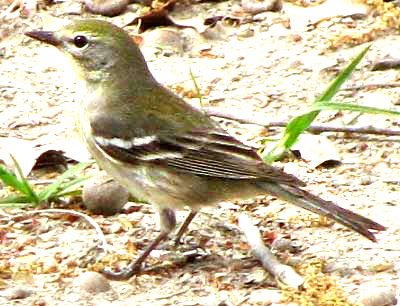Excerpts from Jim Conrad's
Naturalist Newsletter
from the March16, 2009 Newsletter, issued from the forest near Natchez, Mississippi; elevation ~400ft (120m), ~N31.47°, ~W91.29°:
A PINE WARBLER'S TAIL
This week another small bird landed on the ground nearby just long enough for me to snap the picture below:

With its size and slender, insect-eating beak it's clearly a warbler, but it sure is nondescript. Even having the picture on my computer screen I had to work awhile to be sure it was a first-winter Pine Warbler, DENDROICA PINUS, a permanent resident throughout the Southeast's pine zone. During summers Pine Warblers migrate northward throughout the eastern US and southeastern Canada. Since most other warbler species here are present only during the summer, that made it easier to figure out I had the permanent-resident Pine Warbler.
The main other species it could have been at this time of year was a nonbreeding Yellow-rumped Warbler. The main features convincing me that it was a Pine were the relatively long tail and relatively thick beak. Pine Warblers are common here but typically they stay high in the pines where you don't notice these subtle differences. The breeding male is bright yellow and easy to identify.
from the February 10, 2002 Newsletter, issued from near Natchez, Mississippi:
TRILLING PINE WARBLERS
For a couple of weeks the main birding sign that spring is coming is that each morning the Pine Warblers have been trilling. "Trilling" is their song. It's a lot like the Chipping Sparrow's song, but slower, lower, softer, not at all mechanical like the Chipping Sparrow's. He trills with a Southern drawl. Today the Pine Warbler near my trailer has sung longer than usual, undoubtedly because he is feeling extra spring hormones.
Pine Warblers are little yellow birds with slender, insect-eating beaks. They are present here year-round, but they are only summer residents in most of the rest of eastern North America. They are found mostly in mature pine forests, pine barrens and open mixed woodlands, the latter forest type being what we have here.
I like watching this Pine Warbler trill, for when he calls he raises his head as if looking at the sky and he trembles his wings, making it appear to be a heartfelt calling. Something there is in any display of sincerity that always pleases me.